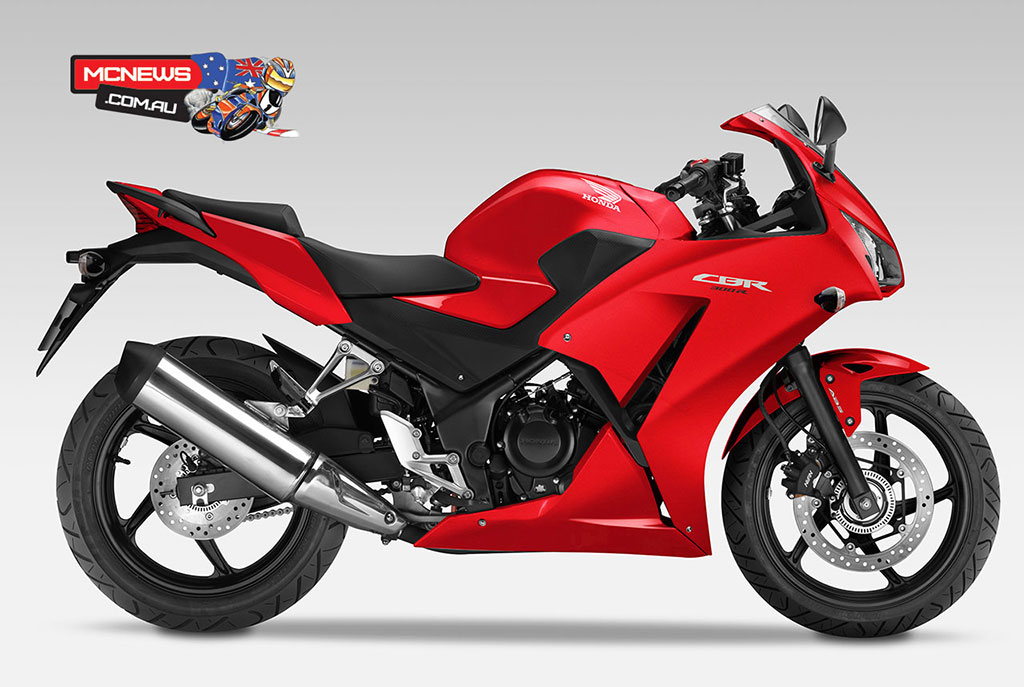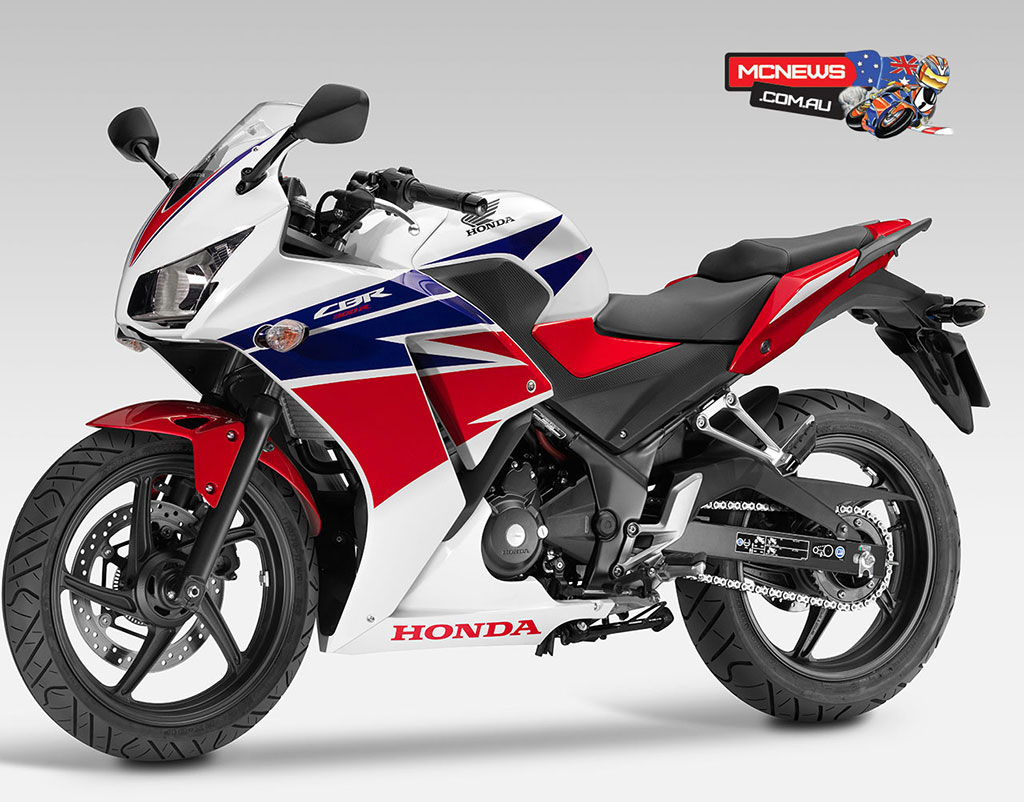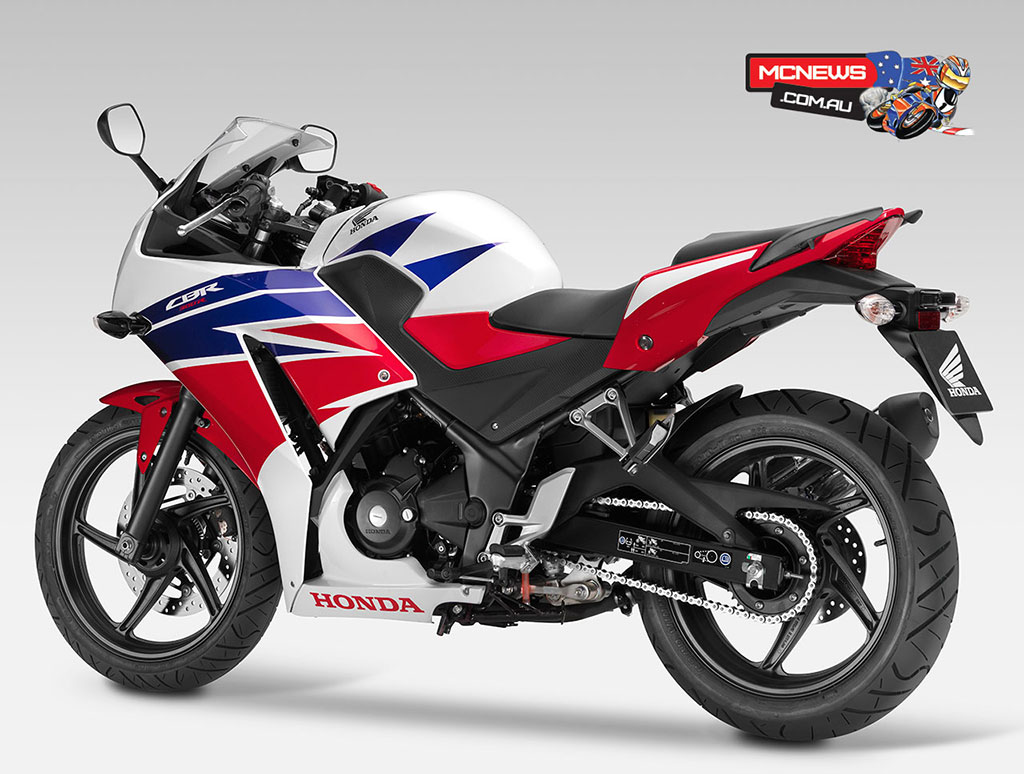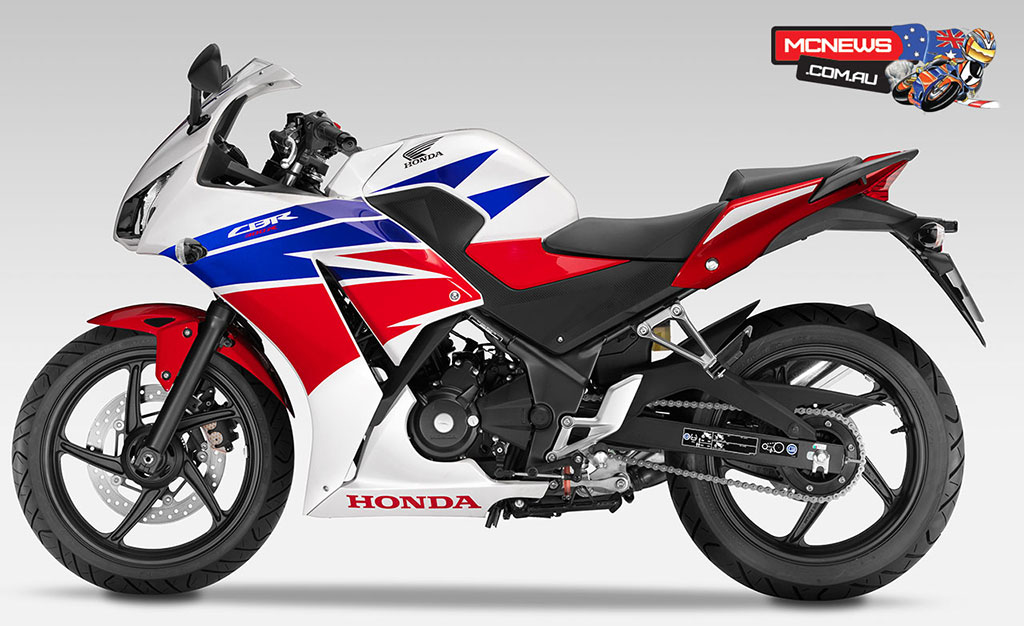Honda’s much-anticipated CBR300R is predicted to dominate the entry-level and mid range sports bike market in Australia, when it goes on sale here in July.
The Honda CBR300R will be available here in two models: Standard (non-ABS) in Black or Red for a Manufacturer’s List price of $5699* and the ABS model, in Black, Red or Tri-Colour for $5999*. (* +ORC)
Honda’s pedigree and the aggressive styling of its famed CBR1000RR sports bike has been brought to a sharply-priced package that offers a list of features which will satisfy the demands of experienced or Learner riders alike.
The Japanese motorcycling giant has taken the best features of the CBR250R and made them even better.
The development approach for the CBR300R took two avenues: more power and torque and a much stronger CBR identity, with stronger visual echoes of its larger capacity siblings, giving a more direct taste of the CBR brand itself.
Firstly, the liquid-cooled engine is now 286cc, achieved through a longer stroke. It has also received upgrades to take full advantage of the increased power, torque and vibration that the larger capacity brings. Work has centred on the engine’s throttle response and power delivery, while a new CBR500R-style exhaust is both an aesthetic and functional upgrade.
The CBR1000RR was design inspiration for the CBR300R’s new look. Dual headlights closely mimic the bigger bike and aggressive styling for the fairing, fuel tank and seat unit are unmistakably CBR. The undercowl is also colour-matched, adding a premium feel.
Compared to larger capacity twin-cylinder machines, the CBR300R is a more compact, lighter and more manageable package for both new and experienced riders, with significantly lower purchase and running costs complementing its flexible and accessible performance.
The CBR300R’s DOHC 4-valve engine retains its 76mm bore, but stroke is increased 8mm to 63mm to give the larger 286cc capacity. Compression ratio remains 10.7:1 and peak power of 22.7kW arrives at 8,500rpm with peak torque of 27Nm at 7,250rpm – a healthy increase over the CBR250R’s output (19.4kW @ 8,500rpm, 23.8Nm @ 7,000rpm).
Countering extra vibration from the longer stroke, the balancer shaft is heavier and the engine’s frame mounts are stronger. The PGM-FI fuel injection – with 38mm throttle bore – has been remapped with a focus on crisp throttle response across the rev range. A new CBR500R-inspired muffler design with larger internal volume adds big-bike style and a pleasing exhaust note.
The CBR300R’s single-cylinder powerplant offers many benefits for any rider. Because the number of moving parts is kept to an absolute minimum, the engine is more fuel efficient, and small details like the low-friction piston rings and iridium spark plug help reduce running costs.
Acceleration is greatly improved thanks to the larger capacity, and the six-speed gearbox’s final drive ratio has been lengthened for more efficient highway speed cruising. Returning 30.2km/l (WMTC mode*), it can cover over 390km on one fill-up of the 13-litre fuel tank.
The mechanical simplicity of the engine reduces servicing costs – another essential element in creating a problem-free ownership experience. It compact size also helps create a bike that is lighter and more manageable than a multi-cylinder, and allows it be positioned perfectly within the chassis for an ideal front/rear weight distribution.
The CBR250R’s design inspiration had echoes of the Sport Touring VFR1200F. For the 2014 CBR300R, styling cues are taken directly from the Super Sport range-topping CBR1000RR with an angular silhouette and aggressive full fairing, colour-matched undercowl, dual headlights and steeply raked rear seat unit.
The riding position has been subtly altered – while seat height remains 785mm, ground reach has been improved with a narrower, re-shaped seat. For a sleeker look both mirrors sit on shorter arms.
A steel diamond twin-spar frame provides the backbone of the CBR300R’s chassis and features a rigidity balance carefully tuned for both a sporty dynamic in corners and stability at speed. Rake is set at 25°05′with trail of 98mm and wheelbase of 1,380mm; kerb weight is a class-leading 164kg.
37mm telescopic forks and Pro-Link rear monoshock provide well-damped, reactive suspension that transmits plenty of feel to the rider. Cast aluminium wheels – rim sizes front 17 x 2.75in and rear 17 x 4in – wear 110/70-17 and 140/70-17 tyres to provide a good combination of grip and agility.
For 2014, standard-fitment lightweight 2-channel ABS is married to the front 296mm disc/two piston caliper and rear 220mm disc/single-piston caliper, for powerful, yet controllable, braking.
The CBR300R will be available in the following colour options: Ross White Tricolore; Millenium Red; Black
Accessories – Single seat cowl; Tail pack; Tank pads; Light alloy front fork bolts; Carbon look front fender; Carbon look drive chain; Immobiliser alarm; U-lock
— Model: Honda CBR300R
- Engine Type – Liquid-cooled 4-stroke 4-valve, DOHC 1-cylinder
- Displacement 286cc
- Bore x Stroke 76mm x 63mm
- Compression Ratio 10.7:1
- Max. Power Output 22.7 kW @ 8,500rpm
- Max. Torque 27.0 Nm @ 7,250rpm
- Oil Capacity 1.8L
- Induction – PGM-FI electronic fuel injection
- Fuel Tank Capacity 13L
- Fuel Consumption 30.2km/l – WMTC mode
- Clutch Type Wet multiplate hydraulic clutch
- Transmission Type 6 speed manual
- Frame – Type Diamond Steel
- Dimensions (LxWxH) 2,035mm x 720mm x 1,120mm
- Wheelbase 1,380mm
- Caster Angle 25°05’
- Trail 98mm
- Seat Height 785mm
- Ground Clearance 145mm
- Kerb Weight 164kg
- Front Suspension – 37mm telescopic fork, 130mm stroke
- Rear Suspension – Monoshock damper, Pro-Link swingarm, 107mm travel
- Rims – Multi-spoke cast aluminium; Front 17M/C×MT2.75; Rear 17M/C×MT4.00
- Tyres – Front 110/70-17; Rear 140/70-17
- Brakes – Front 296mm single hydraulic disc with 2-piston caliper and sintered metal pads. ABS – Rear 220mm single hydraulic disc with single-piston caliper and resin mold pads.
- Instruments- Analogue tachometer, digital odometer, speedometer, fuel gauge, temperature gauge and clock.

















































